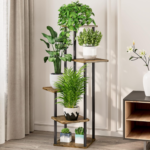Is your living room feeling a bit stale or dull? Imagine walking into a space that breathes along with you. Indoor plants do more than look pretty – they act like natural air filters. Houseplants absorb common pollutants (VOCs like formaldehyde and benzene) and refresh the air. NASA researchers even studied plants to use in space stations, calling them “so efficient at absorbing contaminants” that they help purify indoor environments. In short, adding greenery to your living room can create a fresher, healthier atmosphere – almost like installing a silent air purifier powered by nature.
How Do Plants Clean Indoor Air?

Plants remove toxins through their leaves and roots. They take in carbon dioxide for photosynthesis and can absorb pollutants like formaldehyde, benzene, xylene, and ammonia from the air. Microorganisms in the soil also break down these contaminants. For example, studies show that common houseplants can significantly reduce levels of several key pollutants. Think of each plant as a mini-cleaning unit: its foliage captures impurities and its roots and microbes process them. The result? Cleaner air.
Besides chemicals, many plants also increase humidity and produce more oxygen. Some release moisture vapor, which can help counteract dry indoor air during winter heating. Every deep breath in a plant-filled room can feel fresher.
Benefits Beyond Air Cleaning
Indoor plants do more than scrub air – they improve your well-being. Have you ever felt calmer arranging a bouquet or watering ferns? Research backs this up. One study found that interacting with plants (even simple tasks like repotting) lowers stress and blood pressure. In a science experiment, students studying with live plants were more focused and attentive than those with fake plants or none.
In your living room, plants can also make the space cozier and more welcoming. The greenery can boost creativity, improve mood, and even reduce fatigue. Plus, they act like decor. A tall palm or a vibrant philodendron adds texture and color. In a sense, plants are living furnishings – they decorate your space while working overtime to clean the air and calm your mind.
Factors to Consider: Light, Maintenance, and Safety
Choosing the right plant depends on your living room conditions. Ask yourself: How bright is the room? Do you have pets or kids? How much time can you spend on care?
- Light: Most living rooms have medium to bright indirect light. A south- or west-facing window gives more sun; an interior corner only a bit of diffused light. Match plants to these conditions – some thrive in shade (snake plant, pothos), others need bright light (aloe, gerbera).
- Maintenance: If you’re often busy or forgetful, low-maintenance plants are your friends. Hardy types like snake plants and ZZ plants tolerate neglect – they survive low water and light. Other plants like ferns or peace lilies need more humidity and regular watering.
- Pet/Child Safety: If fur-babies roam your home, pet-safe plants are key. Non-toxic choices include spider plants, areca palms, Boston ferns, and money trees. These won’t harm cats or dogs if nibbled. On the other hand, avoid plants like philodendron, snake plant, or poinsettia around pets – they can cause irritation
By considering light, care, and safety, you pick plants that will truly flourish in your living room, not just look good on day one.
Top Air-Purifying Plants for Living Rooms
Let’s explore specific plants ideal for living rooms. Each of these is known for cleaning the air and has a style suited for indoor decor.
Spider Plant (Chlorophytum comosum)

The Spider Plant has long, arching leaves striped in green and white. It’s one of the easiest houseplants to love. NASA found spider plants remove formaldehyde, xylene, and toluene from the airco2meter.com. They tolerate a wide range of conditions – bright indirect light or even lower light, and they bounce back from drought. Bonus: spider plants are non-toxic to dogs and cats, making them pet-friendlyaspca.org. In a hanging basket or pot on a shelf, baby spiderettes (plantlets) often drape charmingly. Care is simple: just moderate watering and average indoor light.
Snake Plant (Sansevieria trifasciata)
The Snake Plant (aka Mother-in-Law’s Tongue) is nearly indestructible. It has stiff, upright leaves that look like sleek sculptural art. NASA lists snake plants as excellent cleaners of formaldehyde, benzene, xylene, toluene, and even nitrogen oxidesco2meter.com. They do best with infrequent watering and low to medium light. Talk about low-maintenance! One note: snake plants are toxic to petsaspca.org (and humans if ingested), so place them high or separate if you have curious cats or children. Otherwise, this hardy beauty rewards neglect and will make your living room look dramatic and clean.
Peace Lily (Spathiphyllum)

The Peace Lily is famous for its glossy green leaves and elegant white blooms. It’s a champ at removing formaldehyde, benzene, trichloroethylene, xylene, and ammoniaco2meter.com. It thrives in moderate, indirect light. Peace lilies like humidity and moist soil – they even perk up dramatically if you mist them or if the air is a bit humid. If you forget watering, the leaves will droop (like a wilted lily); a drink will soon revive them. Note: Peace Lilies are toxic if ingested (to both people and pets), so keep them out of reach of pets and kids. However, their air-cleaning power and lovely flowers often make them worth the extra caution for adults and households without vulnerable pets.
Areca Palm (Dypsis lutescens)
The Areca Palm (also called Golden Palm) brings a tropical vibe. Its feathery fronds spread upwards and outwards, making it a great statement plant. This palm is great at filtering formaldehyde, xylene, and tolueneco2meter.com. It prefers bright, indirect light (like near a window with sheer curtains) and regular watering (but not soggy soil). Areca palms also add humidity to the air – much like a mini indoor rain forest. The best part? ASPCA lists the Areca Palm as non-toxic to cats and dogsaspca.org. For a living room, a potted Areca in a corner can make the space feel lush and cozy, all while cleaning the air around.
Rubber Plant (Ficus elastica)
The Rubber Plant has large, glossy leaves that can grow quite big. It was also studied by NASA for indoor air quality, known particularly for removing formaldehydeco2meter.com. Rubber plants like bright, indirect light and moderate watering – let the topsoil dry a bit between waterings. In a modern living room, a tall rubber plant can double as a leafy accent. Caution: Ficus species (including rubber plants) can cause mild toxicity in pets if eaten. Keep pets away from nibbling on its leaves.
Golden Pothos (Epipremnum aureum)
Golden Pothos is a popular trailing vine with green and yellow mottled leaves. It was on the NASA list too – it removes formaldehyde, benzene, xylene, and tolueneco2meter.com. Pothos is famous for being nearly foolproof: it will grow in low light or bright light, and forget watering often. Just hang it on a shelf or let it trail from a planter. Pet owners beware: Pothos is toxic to pets (ingesting it causes oral irritation and vomiting)aspca.org. If you have a mischievous cat, consider a pet-safe alternative like a Heartleaf Philodendron (similar appearance but also toxic). Still, many living rooms use pothos for its greenery – it’s one of the best vines for beginners.
Boston Fern (Nephrolepis exaltata)
The classic Boston Fern has arching fronds that spill out of its basket. It topped many lists for its ability to remove formaldehyde and xyleneco2meter.com. Boston ferns prefer high humidity and indirect light. Think of placing one in a bright bathroom or near the living room window. They need regular watering (soil never completely dries out) and occasional misting. The good news: Boston Ferns are non-toxic to petsaspca.org. Their lush green fullness brings a soothing, old-fashioned charm to a living space – like bringing a bit of a forest indoors.
Chinese Evergreen (Aglaonema)
Chinese Evergreens are known for their striking patterned leaves (silver, pink, and green varieties abound). NASA recognized Aglaonema as effective at removing formaldehyde and benzeneco2meter.com. They thrive in very low light and only need watering every week or two. Essentially, this plant is “set-and-forget” – it grows steadily without fussy care. One reviewer even calls it a “powerhouse” that scrubs air clean of pollutantsgreg.app. However, a caution: Chinese Evergreens are toxic to pets if chewedaspca.org. Keep them on high shelves if you have dogs or cats. If you can safely place one, its colorful foliage and hardiness make it perfect for darker corners of the living room.
Pet-Friendly Air-Purifying Plants
Worried about Fido or Fluffy? There are plenty of safe options. Spider plants are pet-friendlyaspca.org and earn bonus points for ease. Boston ferns and areca palms are also on the “OK” listaspca.orgaspca.org. Some modern sellers recommend Calathea (prayer plants) for pet homes – Bloombox Club notes calatheas have air-purifying qualities and are “excellent pet-safe plants”bloomboxclub.com. The Money Tree (Pachira aquatica) is another non-toxic favoriteaspca.org – it has a braided trunk and broad leaves that lend a tropical flair.
In general, if an ASPCA list shows a plant as non-toxic to dogs and cats, it’s a relatively safe bet for pet ownersaspca.orgaspca.org. Always double-check before placing any greenery within reach of curious paws.
Low-Maintenance Air Purifiers
Some living rooms are bright, airy, and spacious – others, not so much. Low-light or low-care plants include snake plants, ZZ plants (Zamioculcas), Chinese evergreens, and pothos. These plants won’t wither if you miss a watering and they survive with little light. For example, a Snake Plant can live in a corner with almost no sun, while still cleaning up formaldehydeco2meter.com. A ZZ Plant (though not in NASA’s official list) is often recommended for very low light – its shiny leaves can also help absorb indoor toxins. Peace Lilies even will bloom in dim corners (though they crave humidity).
Tip: Choose plants that suit your routine. Busy or new plant parents might love “pup” or runner plants like pothos or spider plants; they will forgive neglect (and even produce baby plants!).
Caring for Your Air-Purifying Plants
Proper care maximizes air purifying power. Keep these tips in mind:
- Watering: Overwatering is the most common killer. Most houseplants prefer to dry slightly between waterings. (Check the top inch of soil – if it’s dry, time to water.) A great rule: most plants want water when the soil is somewhat dry, not dripping wet.
- Soil and Feeding: Use a well-draining potting mix. Add slow-release fertilizer during the growing season. Avoid hard fertilizers around pet plants – stick to gentle, natural plant foods.
Signs of Overwatering:
Yellowing leaves, mushy stems, or a sour smell from the pot can indicate too much water. If you see these, let the soil dry out or repot into fresh, dry soil. Proper watering keeps roots healthy to absorb air toxins.
- Light Placement: South/east windows give strong light; north windows or interior spots are dim. Match plant to space – aloe and succulents need bright light, whereas ferns and dracaena adapt to lower light.
- Humidity and Temperature: Many air plants (like ferns and peace lilies) love humidity. In winter, indoor air is dry; mist plants or group them near each other to boost humidity. Keep plants away from cold drafts or hot radiators. Generally, room temperature (65–75°F) is perfect.
With consistent care – some watering, occasional feeding, and proper light – these plants will stay vigorous. Healthy plants clean more air.
Conclusion
Bringing air-purifying plants into your living room is like adding living, breathing decor with hidden superpowers. They don’t just look great – they pull dangerous VOCs from the air, add humidity, and even boost your mood. The Spider Plant, Snake Plant, Areca Palm, Peace Lily, and friends each have unique filters and care needs. Choose varieties that fit your light and lifestyle: low-light tolerant ones for dim corners, pet-safe ones if you have furry friends, and low-maintenance ones if you’re busy. With a little watering and the right spot, your living room can become a greener, fresher oasis. So why not give your plants a prominent spot? Your lungs (and your decor) will thank you.
FAQs
- Q: Do indoor plants really improve air quality? A: Yes. Many studies (including NASA’s) show plants can reduce indoor pollutants like formaldehyde and benzeneco2meter.comco2meter.com. While a single plant won’t replace a filter, a collection of common houseplants significantly helps scrub the air over time.
- Q: Which living room plants are safe for pets? A: Non-toxic options include Spider Plantaspca.org, Boston Fernaspca.org, Areca Palmaspca.org, and Money Treeaspca.org. Always verify with an ASPCA list. Even safe plants should be placed out of reach to avoid pests.
- Q: How many plants do I need for noticeable effects? A: There’s no strict number, but more is better. The NASA research suggests a few large plants or many small ones (as many as one plant per 100 square feet) to maximize filtration. In practice, every plant adds up. Even a handful of green friends can make the air feel fresher and room more lively.
- Q: Can plants replace an air purifier? A: They can help, but plants work slowly. Air purifiers actively filter air, while plants detoxify bit by bit and release oxygen. For best results, use both: plants for continuous, low-maintenance purification, and a quality purifier for quick removal of allergens or smoke.
- Q: What are the easiest air-purifying plants to care for? A: Snake Plants, Pothos, ZZ Plants, and Spider Plants are top easy-care picks. They survive low light and irregular watering. Spider Plants even produce “babies” you can re-pot. These tough houseplants clean the air without demanding much attention, perfect for plant beginners or busy people.






